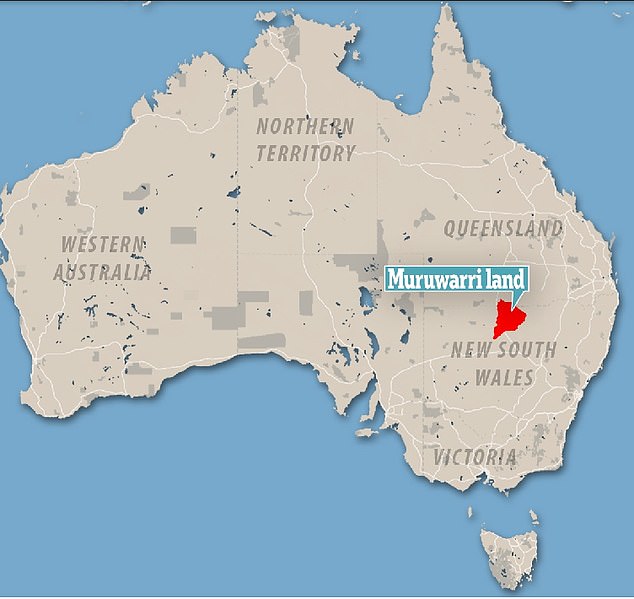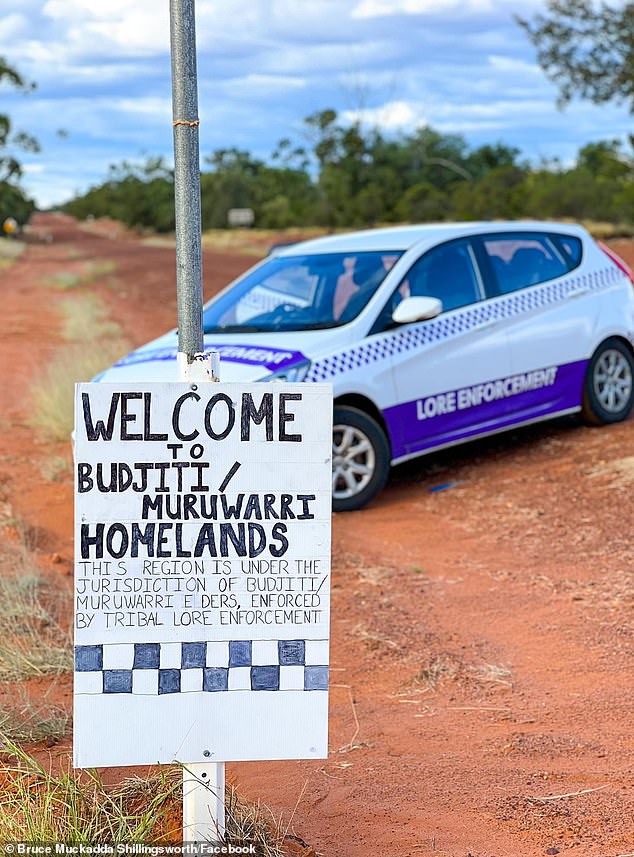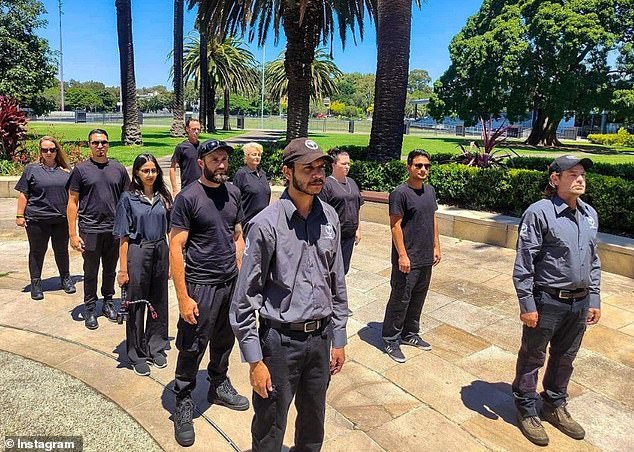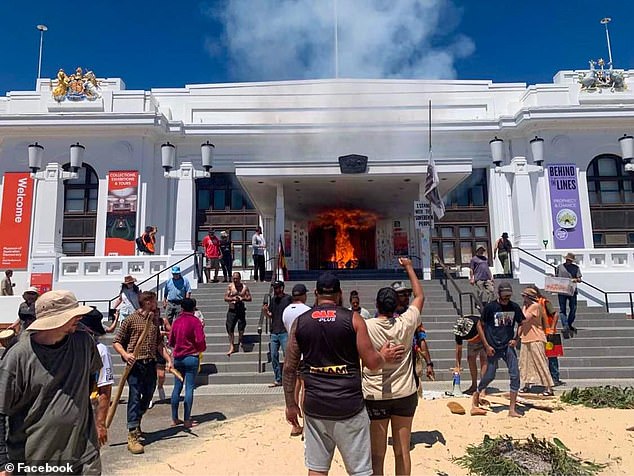Bruce ‘Muckadda’ Shillingsworth dresses as a ‘cop’ and patrols a 200km-square piece of land in western NSW his mob controls under ‘Tribal Lore Enforcement’ – and he’s got no problem blocking police who ‘trespass’
A Native man found guilty of helping set a fire that caused $5.3 million in damage to the Old Parliament House is a hard-line activist who heads what he calls a “Tribal Lore Enforcement” body.
Bruce ‘Muckadda’ Shillingsworth posts videos on social media of him advising First Nations people on how to deal with the NSW police, whom he refers to as ‘foreign private company agents’, and has been filmed blocking their way.
The 32-year-old founded the unarmed Tribal Lore Enforcement in northwest NSW four years ago with his father Bruce ‘Mundagutta’ Shillingsworth.
On Monday, Shillingsworth Jr. convicted of complicity in arson and destruction of Commonwealth property in connection with the December 2021 Old Parliament House fire.
He appeared before the Supreme Court of the ACT dressed in a traditional headdress and loincloth, and swathed in kangaroo skin inscribed with a Declaration of Independence signed by “his people.”
A jury had reviewed CCTV footage of the Muruwarri and Budjiti man, referring to “eviction papers” posted at the entrance to the historic Canberra building before the doors were set on fire.
“We made that notice,” Shillingsworth told his fellow protesters. “An immediate notice of eviction… We tell them to move immediately.”
Shillingsworth runs a popular Facebook page where he shares statements such as “First Nations have supreme power, jurisdiction and authority over their land.”
He appeared in a black and gray uniform and drove a white Hyundai Accent with a police-like checkered pattern and the words “Lore Enforcement” on the side.
Tribal Lore Enforcement covers an area of approximately 200 square kilometers and a population of between 2,000 and 3,000 – most of them indigenous – from Bourke to Enngonia, near the Queensland border.
Shillingsworth told Daily Mail Australia that Tribal Lore Enforcement, which recently acquired a Toyota Hilux four-wheel drive, was different from a government-run police force.
An Indigenous man, filmed preventing police from using public roads through traditional areas of Australia’s outback, leads an independent Tribal Lore Enforcement force. Bruce ‘Muckadda’ Shillingsworth is pictured driving a vehicle marked ‘Lore Enforcement’

The land of Muruwarri extends over 16,000 square kilometers. The area covered by Tribal Lore Enforcement covers approximately 200 square kilometres, from Bourke to Enngonia, near the Queensland border.
“First of all, there is a difference between law and tradition,” he said. “Tradition refers to natural knowledge.
“First Nations people have a close relationship with the land, the flora, the fauna, everything. So it is very different from man-made laws.
“This is not something we just created. We’ve had this system since our existence. We have been doing this for thousands and thousands of years.
“It is very good for us that we can take our systems and processes to the next level, so that we can manage our own affairs.”
Shillingsworth said a large part of Tribal Lore Enforcement’s work was helping young people understand their cultural roles and responsibilities as they “handled our affairs within our nations.”
“It’s worked so far, but as you can see there’s a bit of conflict with the system in recognizing our jurisdiction or our existence, as well as our knowledge, skills and expertise,” he said.

Tribal Lore Enforcement covers an area of approximately 200 square kilometers and a population of between 2,000 and 3,000 – most of them indigenous – from Bourke to Enngonia, near the Queensland border
“A lot of people look at that situation and apply the racial narrative. Race is not part of that in any way. It’s about the construction of the police.
“I didn’t care if they were black or white in that uniform. It is their construction that creates the illusion that they have more power, jurisdiction and authority than natural tradition.
And what we say is: no, that’s not the case. It does not detract from natural knowledge wherever you are.’
Shillingsworth was filmed last year during a confrontation with police responding to reports of illegal squatting at the Ledknapper Nature Reserve in Enngonia.
“We’ve got the police here,” Shillingsworth tells the camera.
“What happens is they move into Muruwarri land and think they have authority. I’m going to ask them here now if they have jurisdiction.
One of the officers steps in and tells Shillingsworth, “You’re blocking a public road.”

Shillingsworth parades Tribal Lore Enforcement supporters at Redfern Park in Sydney’s inner city on January 26 this year for a day of ‘training and capacity building’
Another cop says, “You’re blocking a lane, move your vehicle.” This is a roadway in New South Wales.”
Shillingsworth tells the officers again, ‘This is Muruwarri land,’ before warning them not to enter traditional Aboriginal land.
After being ordered to move his car, Shillingsworth identifies himself as a ‘Lore Enforcement officer’.
‘You are committing an offense because that land is Muruwarri land from now on and you should know that,” says Shillingsworth.
Mr Shillingsworth was subsequently charged with obstructing traffic and disregarding directions following the incident, which took place in March last year.
He was found guilty of both offenses and fined $400 after a September 2022 hearing at Bourke Local Court.
Shillingsworth was back in court in July when he pleaded guilty to using a recording device in court and posting the results on social media. Without conviction, he was given a nine-month parole.

Bruce Shillingsworth was found guilty on September 4 of complicity in arson and damaging Commonwealth property over a fire at Old Parliament House in December 2021 (above)
In another confrontation, this time outside the Oasis Hotel in Enngonia in April 2022, Shillingsworth again objected to the police presence on Muruwarri land.
“You are committing an offence,” Shillingsworth tells police in a video of that encounter. “We’ve issued you with an eviction notice and now you’re going over it.
“This is the second time we’ve issued a warning. The next time you enter Muruwarri land, you may be prosecuted under our law and you may be arrested. Do you understand?’
Shillingsworth said about 30 people were involved in Tribal Lore Enforcement, which was privately funded and partnered with other groups, including local farmers.
“We’re self-sufficient so we’re less vulnerable to getting caught up in other companies’ narrative,” he said. And it’s not that hard to find.
‘There is an alternative way of dealing with certain things, but also of seeing things as a community. It’s working so far and seems to be getting a lot of traction, which is really good.”
The father of four said he did not want a conflict with NSW police.
“As you’ve seen in some of the videos, it’s not very well received by the police for a number of reasons,” Shillingsworth said.
“There is an illusion that they have more power, jurisdiction or authority than the First Nations people who have lived here for thousands upon thousands of years.”
Shillingsworth was set to vote ‘no’ in the Indigenous Voice to Parliament referendum, but said the issue was barely discussed in his home country.
“I would say a majority of our people don’t know about it,” he said. ‘If you ask people in our region about the Voice, they don’t know anything about it.’
Muruwarri country stretches over 16,000 square kilometers from Barringun on the Queensland-NSW border to Mulga Downs and Weela in southern Queensland.
It includes Enngonia on the Warrego River, Brenda and Weilmoringle on the Culgoa River, and as far south as Milroy and Collerina in NSW.
